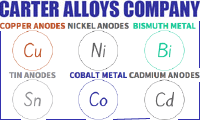
-----
Cadmium Plating is smutty and powdery
Q. I am working with a aged cadmium process and we have been experiencing issues with the cadmium plating onto the product in a manner that seems to leave a dull or powdery surface. I am operating at about 1.5 volts with about 20 amps per square foot. The tank itself has very recently been totally remade using a new liner and new chemicals. We are plating 4130 steel panels for corrosion, that are in great condition (vinyl coating on both sides), The only thing we haven't replaced in the tank itself is the anodes. They appear to be older and pitted to some degree. We would like to get totally away from this powder or smutty surface. Any suggestions?
Robert BrownProcess Supervisor - Birmingham, Alabama
December 10, 2009
A. Come back and tell us: Sodium Cyanide concentration, metal concentration, carbonate concentration. Are the anode baskets steel or titanium (a no,no)? And you usually need a nickel strike activation on the 4000's series steel.

Robert H Probert
Robert H Probert Technical Services
Garner, North Carolina

December 10, 2009
A. As well as what Robert said, I would check to see if all of the residue from the vinyl had been removed. Try a water break test.
James Watts- Navarre, Florida
December 11, 2009
A. In addition to the above variables, are you using any type of proprietary additives?
Gene Packman- Great Neck, New York
December 12, 2009
Q. My NaCN is currently running at 12.0 oz/gal, NaOH is at 3.9 oz/gal. The tank is very new and has a low Carbonates level. The steel plates we are using are 4130 grade steel and are cleaned of the vinyl coating residue utilizing a hand wipe and a vapor degreasing operation.
It seems that the Cadmium plating is plating heaviest at the outer edges of the specimen and that is where the heaviest "smutting" seems to occur.
The baskets are steel, although I was told to try to get stainless baskets. During Inspection of the baskets we noticed that the Cadmium anodes seem to be old and porous. We have ordered new anodes and are awaiting arrival.
I was also advised to reverse the current and process a specimen to "plate out" any contaminants that may be in the tank. I don't know if this will work but we can give it a try.
Process Supervisor - Birmingham, Alabama
December 16, 2009
First of two simultaneous responses --
A. Thank you for more info. We still need to know the metal concentration, because it is the ratio of CN/Cd that governs deposit distribution and deposit clarity. The metal should be about 2.5 to 3 oz/gal and the cyanide at about 17 to 19 oz/gal. Also you need some sort of "activation" (platers' term for removing oxides) on the 4130, preferably a Woods Strike (2 #/gal Nickel Chloride and 1 quart per gallon HCl using RD Nickel anodes AND NOT S-ROUNDS).
Do not use stainless baskets, use steel. The anodes should be fluffy black, if not the CN/Cd ratio is low. With higher cyanide the deposit will go more uniform and less burn on the edges. Do not reverse the current as it will increase the metal content which is already too high. If you are not using a proprietary brightener, then add about 1 oz/gal nickel sulphate to the cadmium plating solution
(add it slowly as it will make carbonates and liberate CN gas).
Come on back with more info, we will get this right yet !

Robert H Probert
Robert H Probert Technical Services
Garner, North Carolina

December 16, 2009
Second of two simultaneous responses --
A. Robert,
Whatever you do, please don't reverse current with your anodes and anode baskets in, if there is any metallic contamination it will plate directly onto them so that when you plate in the right direction you will dissolve the contaminant back into the solution.
If you feel you have a contamination problem then use a mild steel sheet with a large surface area and plate at a low current density for a while (it is known a dummying out).
If you are getting powdery deposits at the edges it sounds as if you are getting "burning". This is normally caused by too high a current density. You will find you are getting excessive build-up in these areas as well. Try reducing your current and see what happens.
Aerospace - Yeovil, Somerset, UK
December 17, 2009
April 11, 2012
Q. Help, for the past 3 weeks I've been trying to get my companies Cadmium Plating line up and running. The problem I am running into is that there is smutting on the parts. After each new run the smutting seems to lessen, but there is still visible smutting. I've tried changing the chemistry of our Cd tanks, increasing the amperage, I've even tried increasing the thickness of the Nickel Strike base coat. I now need ideas from the experts.
The required specs for our Cd tank in oz/gallon are:
Cd conc 2.3-4.5
NaCN conc 9-17.5
NaOH conc 1.6-3.2
Na2CO3 conc 2-8
Right now my tank is at:
Cd 2.93
NaCN 14.2
NaOH 2.07
Na2CO3 5.5
Also I would like to know if there is a reason my rectifier loses amperage during the plating process. For 10-30 seconds I will see the needle drop from 100 amps to 50 amps. I am not sure if this is effecting the plating, but it is bothersome to me.
And, if it helps we plate small fasteners about half an inch in length and 1/8th inch diameter in a barrel.
Thanks for taking the time to read this, and replying
plating shop employee - Canby, Oregon, USA
adv.: Supplier of Copper Anodes, Nickel Anodes, Bismuth Metal, & Other Metal Products for Industry & The Arts

Q, A, or Comment on THIS thread -or- Start a NEW Thread